Barriers to BIM Implementation in Architecture, Construction, and Engineering Projects—The Polish Study
Abstract
1. Introduction
2. Literature Studies—Identifying Barriers to BIM Implementation in the World
3. Method and Materials
3.1. The Ishikawa Diagram
- “fish head”—it is the result of defect and, at the same time, a problem to be solved;
- “spine”—brings together individual groups of causes,
- “bones”—indicate causes included in a given category.
3.2. Identifying Possible Causes for a Problem
4. Results and Discussion
4.1. Identyfication of Barriers to BIM Implementation in Polish Architecture, Engineering and Construction Sectors
4.2. Cause and Effect Analysis
4.3. Final Results and Discussion: The Most Important Barriers Limiting the Full Implementation of BIM Technology to the Construction Process
- Low level of knowledge about BIM technology
- Low level of awareness of the benefits of using BIM technology
- Low prices of construction documentation (projects, cost estimates)
5. Conclusions
Author Contributions
Funding
Institutional Review Board Statement
Informed Consent Statement
Data Availability Statement
Conflicts of Interest
References
- Lee, S.; Ha, M. Customer interactive building information modeling for apartment unit design. Autom. Constr. 2013, 35, 424–430. [Google Scholar] [CrossRef]
- Isikdag, U.; Zlatanova, S. A SWOT analysis on the implementation of Building Information Models within the Geospatial Environment. In Urban and Regional Data Management; UDMS Annual 2009, Taylor & Francis Group; CRC Press: Wageningen, The Netherlands, 2009; pp. 15–30. [Google Scholar]
- US National Institute of Building Sciences. National Building Information Modelling Standard, Version 1—Part 1: Overview, Principles, and Methodologies; Glossary; National Institute of Building Sciences: Washington, DC, USA, 2007. [Google Scholar]
- Trach, R.; Pawluk, K.; Lendo-Siwicka, M. The assessment of the effect of BIM and IPD on construction projects in Ukraine. Int. J. Constr. Manag. 2020, 1, 1562–3599. [Google Scholar] [CrossRef]
- Zima, K.; Plebankiewicz, E.; Wieczorek, D. A SWOT Analysis of the Use of BIM Technology in the Polish Construction Industry. Buildings 2020, 10, 16. [Google Scholar] [CrossRef]
- Eastman, C.; Teicholz, P.; Sacks, R.; Liston, K. BIM Handbook A: A Guide to Building Information Modeling for Owners, Managers, Designers, Engineers, and Contractors; WILEY: Hoboken, NJ, USA, 2011. [Google Scholar]
- Frequently Asked Questions about the National BIM Standard-United States™. Available online: https://www.nationalbimstandard.org/faqs (accessed on 22 September 2020).
- Eastman, C. BIM Handbook: A Guide to Building Information Modeling for Owners, Managers, Designers, Engineers and Contractors; Wiley: Hoboken, NJ, USA, 2008. [Google Scholar]
- Jung, Y.; Joo, M. Building information modeling (BIM) framework for practical implementation. Autom. Constr. 2011, 20, 126–133. [Google Scholar] [CrossRef]
- Kim, H. Generating construction schedules through automatic data extraction using open BIM (building information modeling) technology. Autom. Constr. 2013, 35, 285–295. [Google Scholar] [CrossRef]
- Ding, L.; Zhou, Y.; Akinci, B. Building Information modeling (BIM) application framework: The process of expanding from 3D to computable. Autom. Constr. 2014, 46, 82–93. [Google Scholar] [CrossRef]
- Demian, P.; Walters, D. The advantages of information management through building information modeling. J. Constr. Manag. Econ. 2014, 32, 1153–1165. [Google Scholar] [CrossRef]
- Konior, J.; Szóstak, M. Methodology of Planning the Course of the Cumulative Cost Curve in Construction Projects. Sustainability 2020, 12, 2347. [Google Scholar] [CrossRef]
- Potrč Obrecht, T.; Röck, M.; Hoxha, E.; Passer, A. BIM and LCA Integration: A Systematic Literature Review. Sustainability 2020, 12, 5534. [Google Scholar]
- Mistretta, F.; Sanna, G.; Stochino, F.; Vacca, G. Structure from motion point clouds for structural monitoring. Remote Sens. 2019, 11, 1940. [Google Scholar] [CrossRef]
- Farzaneh, A.; Monfet, D.; Forgues, D. Review of using Building Information Modeling for building energy modeling during the design process. J. Build. Eng. 2019, 23, 127–135. [Google Scholar] [CrossRef]
- Ramaji, E.; Memari, A.M. Review of BIM’s application in energy simulation: Tools, issues, and solutions. Autom. Constr. 2019, 97, 164–180. [Google Scholar]
- Bonomolo, M.; Di Lisi, S.; Leone, G. Building Information Modelling and Energy Simulation for Architecture Design. Appl. Sci. 2021, 11, 2252. [Google Scholar]
- Bastos Porsani, G.; Del Valle de Lersundi, K.; Sánchez-Ostiz Gutiérrez, A.; Fernández Bandera, C. Interoperability between Building Information Modelling (BIM) and Building Energy Model (BEM). Appl. Sci. 2021, 11, 2167. [Google Scholar]
- Gómez Melgar, S.; Sánchez Cordero, A.; Videras Rodríguez, M.; Andújar Márquez, J.M. Matching Energy Consumption and Photovoltaic Production in a Retrofitted Dwelling in Subtropical Climate without a Backup System. Energies 2020, 13, 6026. [Google Scholar] [CrossRef]
- Jeong, W.; Yan, W.; Lee, C.J. Thermal Performance Visualization Using Object-Oriented Physical and Building Information Modeling. Appl. Sci. 2020, 10, 5888. [Google Scholar] [CrossRef]
- Bruno, N.; Roncella, R. HBIM for Conservation: A New Proposal for Information Modeling. Remote Sens. 2019, 11, 1751. [Google Scholar] [CrossRef]
- Sztubecki, J.; Mrówczyńska, M.; Bujarkiewicz, A. Proposition of determination of displacements using the TDRA 6000 laser station. E3S Web Conf. 2018, 55, 00011. [Google Scholar] [CrossRef]
- Tommasi, C.; Achille, C.; Fassi, F. From point cloud to BIM: A modelling challenge in the Cultural Heritage field. Int. Arch. Photogramm. Remote Sens. Spat. Inf. Sci. 2016, XLI-B5, 429–436. [Google Scholar]
- Giresini, L.; Stochino, F.; Sassu, M. Economic vs environmental isocost and isoperformance curves for the seismic and energy improvement of buildings considering Life Cycle Assessment. Eng. Struct. 2021, 233, 111923. [Google Scholar] [CrossRef]
- Akkurt, G.G.; Aste, N.; Borderon, J.; Buda, A.; Calzolari, M.; Chung, D.; Costanzo, V.; del Pero, C.; Evola, G.; Huerto-Cardenas, H.E.; et al. Dynamic thermal and hygrometric simulation of historical buildings: Critical factors and possible solutions. Renew. Sustain. Energy Rev. 2020, 118, 109509. [Google Scholar] [CrossRef]
- Ozturk, G.B. Identifying the advantages of BIM in structural design. Eurasian J. Civ. Eng. Archit. 2018, 2, 25–32. [Google Scholar]
- Shin, M.H.; Lee, H.K.; Kim, H.Y. Benefit–Cost Analysis of Building Information Modeling (BIM) in a Railway Site. Sustainability 2018, 10, 4303. [Google Scholar] [CrossRef]
- Sarvari, H.; Chan, D.W.M.; Rakhshanifar, M.; Banaitiene, N.; Banaitis, A. Evaluating the Impact of Building Information Modeling (BIM) on Mass House Building Projects. Buildings 2020, 10, 35. [Google Scholar] [CrossRef]
- McAuley, B.; Hore, A.; West, R. BICP Global BIM Study—Lessons for Ireland’s BIM Programme; Construction IT Alliance (CitA) Limited: New York, NY, USA, 2017. [Google Scholar]
- Ishikawa, K. What is Total Quality Control. In The Japanese Way; Prentice Hall: Englewood Cliffs, NJ, USA, 1985. [Google Scholar]
- Al-Ashmori, Y.Y.; Othman, I.; Rahmawati, Y. Bibliographic analysis of BIM Success Factors and Other BIM Literatures using Vosviewer: A Theoretical Mapping and Discussion. J. Phys. Conf. Ser. IOP Publ. 2020, 1529, 42105. [Google Scholar] [CrossRef]
- Hamma-adama, M.; Kouider, T.; Salman, H. Analysis of barriers and drivers for BIM adoption. Int. J. BIMa Eng. Sci. 2020, 3, 18–41. [Google Scholar]
- Oraee, M.; Hosseini, M.R.; Edwards, D.J.; Li, H.; Papadonikolaki, E.; Cao, D. Collaboration barriers in BIM-based construction networks: A conceptual model. Int. J. Proj. Manag. 2019, 37, 839–854. [Google Scholar] [CrossRef]
- Sardroud, J.M.; Mehdizadehtavasani, M.; Khorramabadi, A.; Ranjbardar, A. Barriers Analysis to Effective Implementation of BIM in the Construction Industry. In ISARC. Proceedings of the International Symposium on Automation and Robotics in Construction; IAARC Publications: Berlin, Germany, 2018; Volume 35, pp. 1–8. [Google Scholar]
- Mohammed, A.; Hasnain, S.A.; Quadir, A. Implementation of building information modelling (BIM) practices and challenges in construction industry in Qatar. J. Eng. Res. Rep. 2019, 9, 1–9. [Google Scholar] [CrossRef]
- Wong, S.Y.; Gray, J. Barriers to implementing Building Information Modelling (BIM) in the Malaysian construction industry. In IOP Conference Series: Materials Science and Engineering; IOP Publishing: Bristol, UK, 2019; Volume 495, p. 12002. [Google Scholar]
- Chan, D.W.; Olawumi, T.O.; Ho, A.M. Perceived benefits of and barriers to Building Information Modelling (BIM) implementation in construction: The case of Hong Kong. J. Build. Eng. 2019, 25, 100764. [Google Scholar] [CrossRef]
- Ullah, K.; Lill, I.; Witt, E. An overview of BIM adoption in the construction industry: Benefits and barriers. In Proceedings of the 10th Nordic Conference on Construction Economics and Organization, Tallinn, Estonia, 7–8 May 2019; Volume 10, p. 7250. [Google Scholar]
- Elagiry, M.; Marino, V.; Lasarte, N.; Elguezabal, P.; Messervey, T. BIM4Ren: Barriers to BIM implementation in renovation processes in the Italian market. Buildings 2019, 9, 200. [Google Scholar] [CrossRef]
- Olanrewaju, O.I.; Chileshe, N.; Babarinde, S.A.; Sandanayake, M. Investigating the barriers to building information modeling (BIM) implementation within the Nigerian construction industry. Eng. Constr. Archit. Manag. 2020, 27, 2931–2958. [Google Scholar] [CrossRef]
- Aitbayeva, D.; Hossain, M.A. Building Information Model (BIM) Implementation in Perspective of Kazakhstan: Opportunities and Barriers. J. Eng. Res. Rep. 2020, 14, 13–24. [Google Scholar] [CrossRef]
- Mahdi, M.M.; Mawlood, D.K. Challenges Facing the Implementation of Building Information Modeling (BIM) Techniques in Iraq. Zanco J. Pure Appl. Sci. 2020, 32, 48–57. [Google Scholar]
- Farooq, U.; Rehman, S.K.U.; Javed, M.F.; Jameel, M.; Aslam, F.; Alyousef, R. Investigating BIM Implementation Barriers and Issues in Pakistan Using ISM Approach. Appl. Sci. 2020, 10, 7250. [Google Scholar] [CrossRef]
- Wu, P.; Jin, R.; Xu, Y.; Lin, F.; Dong, Y.; Pan, Z. The analysis of barriers to BIM implementation for industrialized building construction: A China study. J. Civ. Eng. Manag. 2020, 27, 1–13. [Google Scholar] [CrossRef]
- Mignone, G.; Hosseini, M.R.; Chileshe, N.; Arashpour, M. Enhancing collaboration in BIM-based construction networks through organisational discontinuity theory: A case study of the new Royal Adelaide Hospital. Archit. Eng. Des. Manag. 2016, 12, 333–352. [Google Scholar] [CrossRef]
- Kaewunruen, S.; Sresakoolchai, J.; Zhou, Z. Sustainability-based lifecycle management for bridge infrastructure using 6d Bim. Sustainability 2020, 12, 2436. [Google Scholar] [CrossRef]
- Biolek, V.; Hanak, T.; Hanak, M. Proposed interconnecting database for BIM models and construction-economic systems in the Czech Republic. In IOP Conference Series: Materials Science and Engineering; IOP Publishing: Bristol, UK, 2019; Volume 471, p. 112079. [Google Scholar]
- Xu, X.; Mumford, T.; Zou, P.X. Life-cycle building information modelling (BIM) engaged framework for improving building energy performance. Energy Build. 2020, 231, 110496. [Google Scholar] [CrossRef]
- Mesaros, P.; Spisakova, M.; Mandicak, T. Analysing the implementation motivations of BIM Technology in Construction Project Management. In IOP Conference Series: Materials Science and Engineering; IOP Publishing: Bristol, UK, 2020; Volume 960, p. 042064. [Google Scholar]
- Hamidavi, T.; Abrishami, S.; Hosseini, M.R. Towards intelligent structural design of buildings: A BIM-based solution. J. Build. Eng. 2020, 32, 101685. [Google Scholar] [CrossRef]
- Czmoch, I.; Pękala, A. Traditional design versus BIM based design. Procedia Eng. 2014, 91, 210–215. [Google Scholar] [CrossRef]
- Nassery, F.A.R.I.D. BIM Technology in Preservation of Historical City Buildings. Tradit. Herit. Contemp. Image City 2014, 3, 57–64. [Google Scholar]
- Plebankiewicz, E.; Zima, K.; Skibniewski, M. Analysis of the first Polish BIM-Based cost estimation application. Procedia Eng. 2015, 123, 405–414. [Google Scholar] [CrossRef]
- Bonenberg, W.; Wei, X. Green BIM in sustainable infrastructure. Procedia Manuf. 2015, 3, 1654–1659. [Google Scholar] [CrossRef]
- Bartoszek, M.; Juszczyk, M. Selected problems of bim-based planning of construction works–case study. Tech. Trans. 2015, 4, 71–79. [Google Scholar]
- Valinejadshoubi, M.; Bagchi, A.; Moselhi, O. Development of a BIM-based data management system for structural health monitoring with application to modular buildings: Case study. J. Comput. Civ. Eng. 2019, 33, 05019003. [Google Scholar] [CrossRef]
- Jasiński, A. Impact of BIM implementation on architectural practice. Archit. Eng. Des. Manag. 2020, 1–11, 1745–2007. [Google Scholar]
- Ratajczak, J.; Riedl, M.; Matt, D.T. BIM-based and AR application combined with location-based management system for the improvement of the construction performance. Buildings 2019, 9, 118. [Google Scholar] [CrossRef]
- BIM Polish Perspective, Autodesk Report—2015. Available online: https://damassets.autodesk.net/content/dam/autodesk/www/campaigns/bim-event/BIM_raport_final.pdf (accessed on 20 September 2020).
- BIM, Collaboration, Cloud in Polish Construction, Autodesk Report—2019. Available online: https://www.autodesk.pl/campaigns/aec/bim-report-2019#form-section (accessed on 20 September 2020).
- Wong, K.C.; Woo, K.Z.; Woo, K.H. Ishikawa Diagram. In Quality Improvement in Behavioral Health; Springer: Cham, Switzerland, 2016; pp. 119–132. [Google Scholar]
- Ishikawa, K.; Loftus, J.H. Introduction to Quality Control; 3A Corporation: Tokyo, Japan, 1990. [Google Scholar]
- Doggett, A.M. Root Cause Analysis: A Framework for Tool Selection. Qual. Manag. J. 2005, 12, 4. [Google Scholar] [CrossRef]
- Aichouni, M. On the Use of the Basic Quality Tools for the Improvement of the Construction Industry: A Case Study of a Ready Mixed Concrete Production Process. Int. J. Civ. Environ. Eng. 2012, 12, 28–35. [Google Scholar]
- Alaa, A.S.; Pasławski, J.; Nowotarski, P. Quality Management to continuous improvements in process of Ready Mix Concrete production. In IOP Conference Series: Materials Science and Engineering; IOP Publishing: Bristol, UK, 2019; Volume 518, p. 022019. [Google Scholar]
- Topchiy, D.; Bolotova, A.; Vorobev, A.; Atamanenko, A. Reprofiling of objects with monolithic reinforced concrete frame. IOP Conf. Ser. Mater. Sci. Eng. 2020, 890, 012137. [Google Scholar] [CrossRef]
- Hoła, B.; Nowobilski, T.; Szer, I.; Szer, J. Identification of factors affecting the accident rate in the construction industry. Procedia Eng. 2017, 208, 35–42. [Google Scholar] [CrossRef]
- Gündüz, M.; Nielsen, Y.; Özdemir, M. Quantification of delay factors using the relative importance index method for construction projects in Turkey. J. Manag. Eng. 2013, 29, 133–139. [Google Scholar] [CrossRef]
- Parchami Jalal, M.; Noorzai, E.; Yavari Roushan, T. Root cause analysis of the most frequent claims in the building industry through the SCoP3E Ishikawa diagram. J. Leg. Aff. Disput. Resolut. Eng. Constr. 2019, 11, 04519004. [Google Scholar] [CrossRef]
- Joshi, A.; Kale, S.; Chandel, S.; Pal, D.K. Likert scale: Explored and explained. Curr. J. Appl. Sci. Technol. 2015, 3, 96–403. [Google Scholar] [CrossRef]
- Boone, H.N.; Boone, D.A. Analyzing likert data. J. Ext. 2012, 50, 1–5. [Google Scholar]
- Czerwiński, K. Methodological aspects of evaluation of evaluation as a resultant value. In Social Communication and Values in Education. New Meanings and Situations; Maliszewski, W., Ed.; Adam Marszalek Publisher: Toruń, Poland, 2007. [Google Scholar]
- Wiśniewska, M.; Jasiak-Kujawska, A. Analysis of the causes of medical infections using a weighted Ishikawa diagram. Zarządzanie I Finans. 2012, 10, 328–343. [Google Scholar]
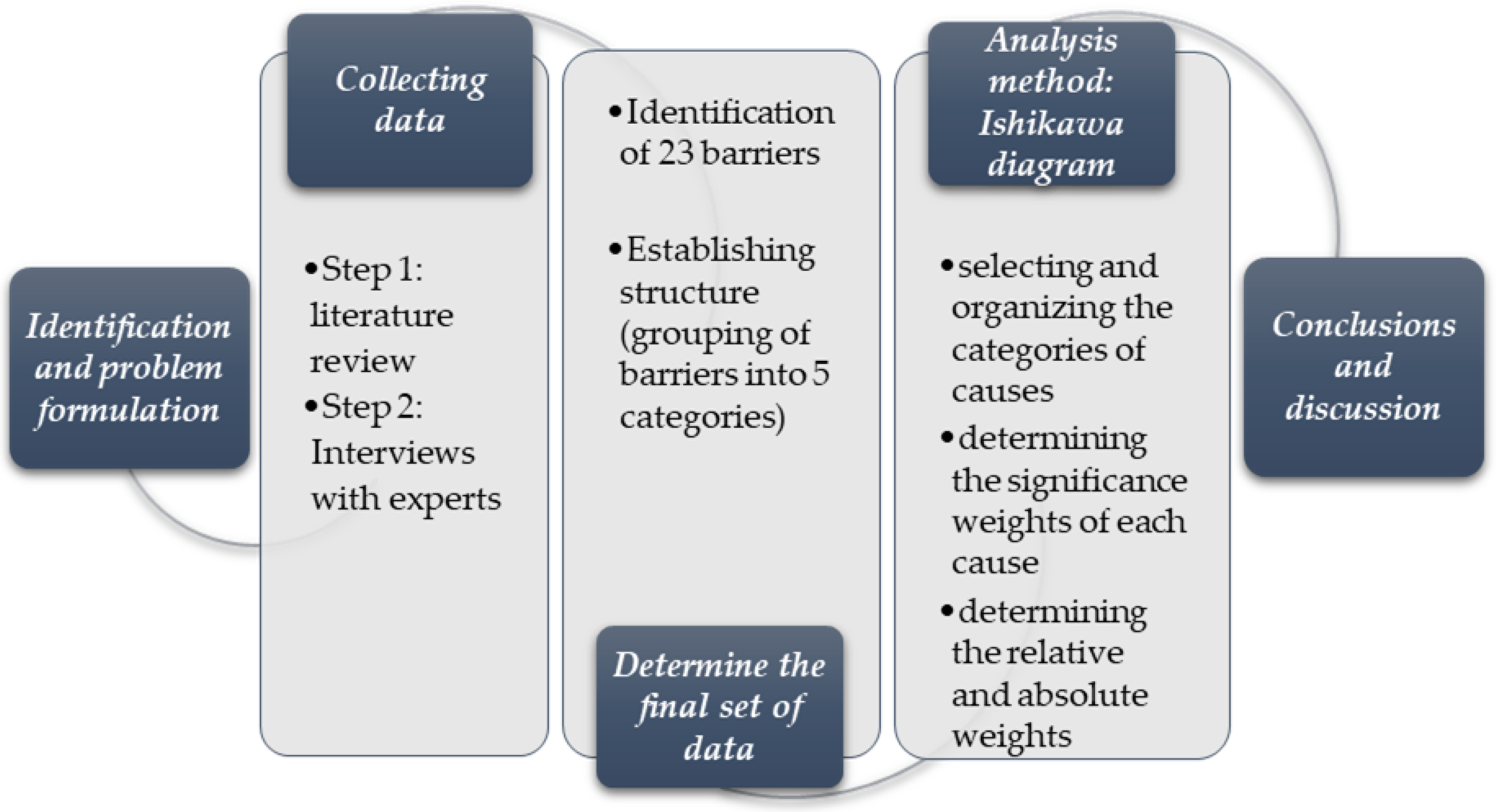


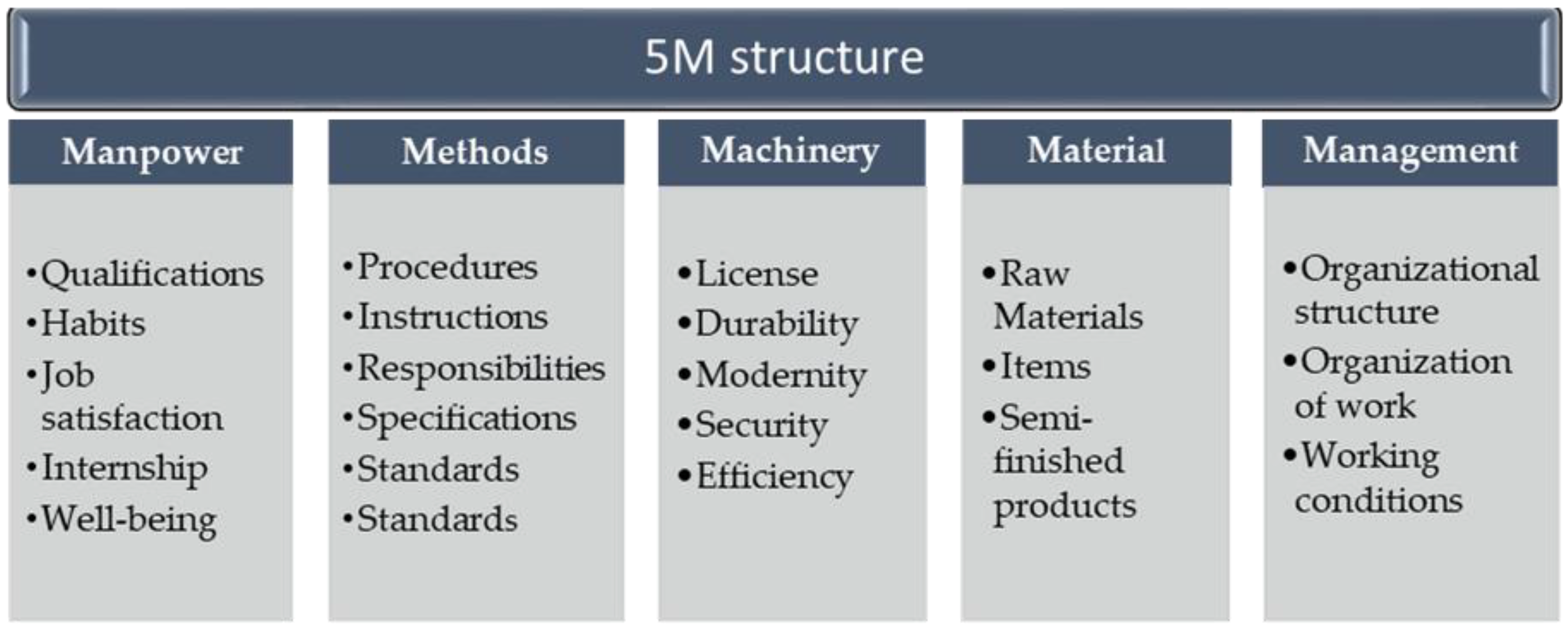
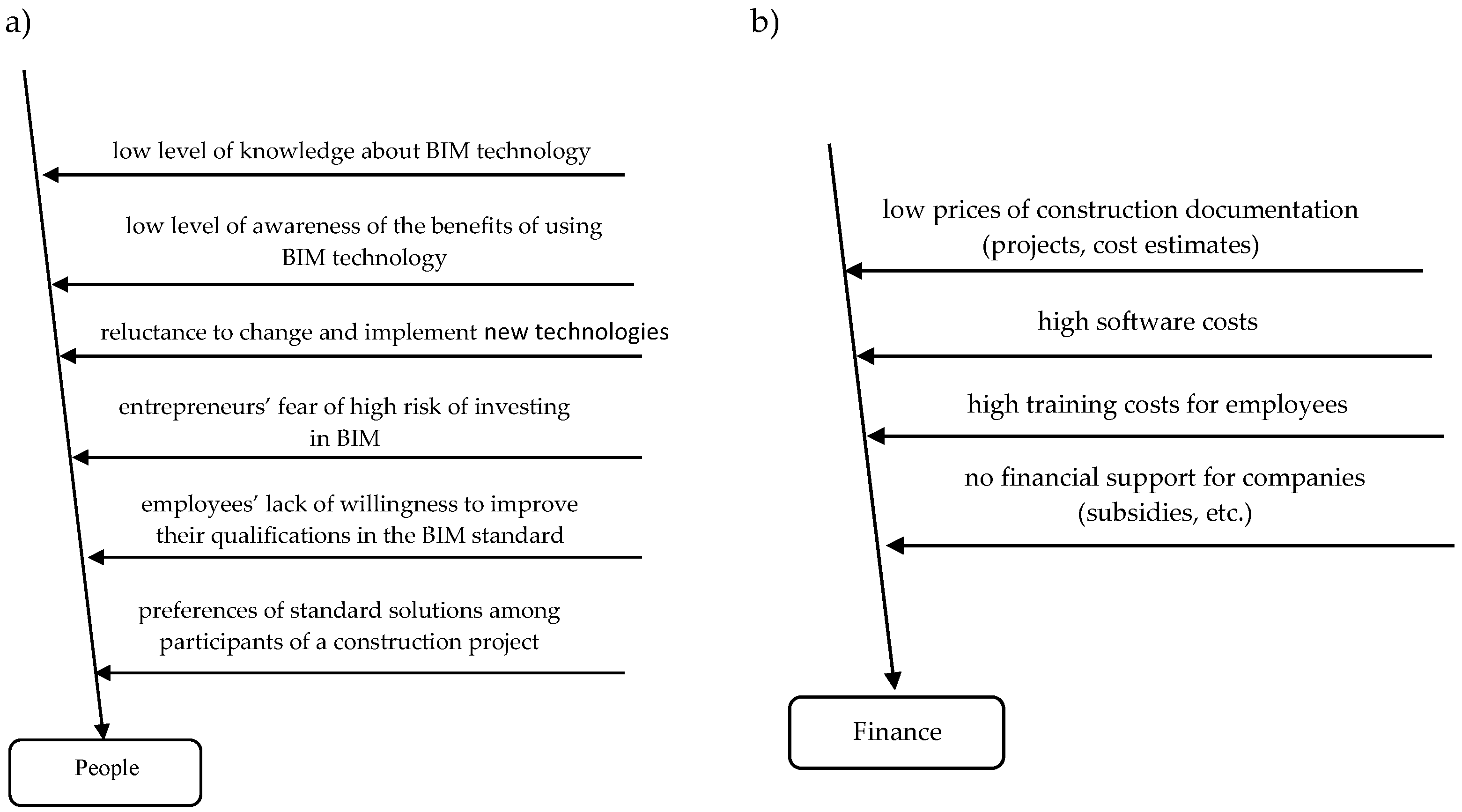
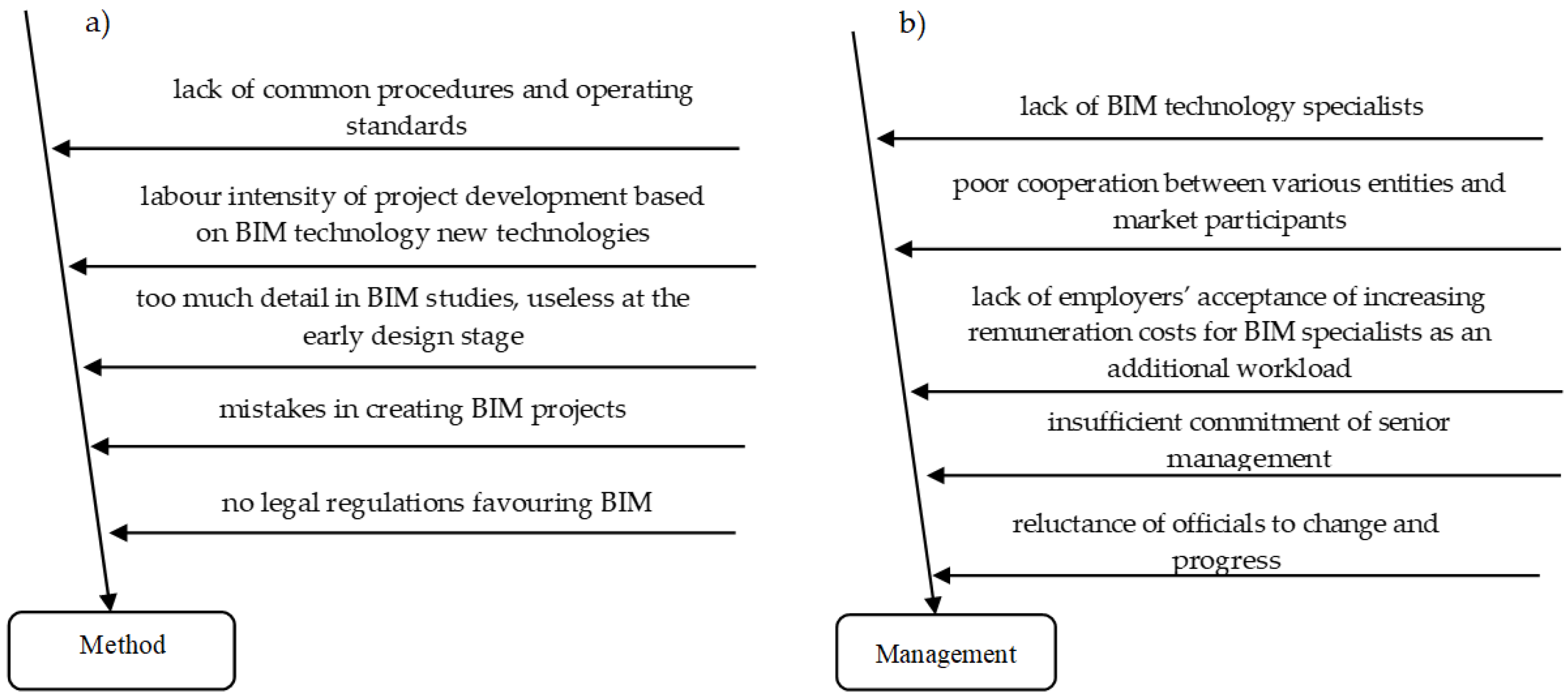

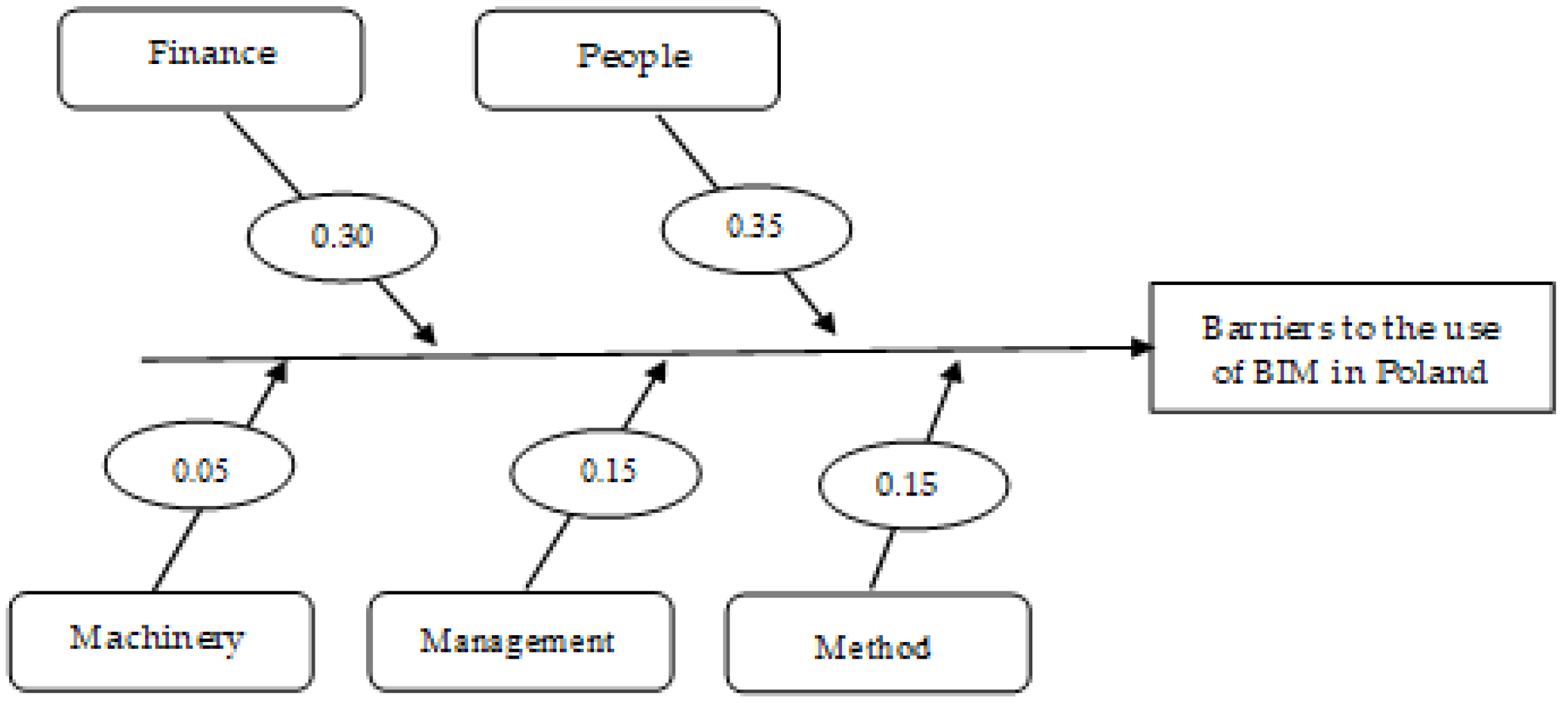
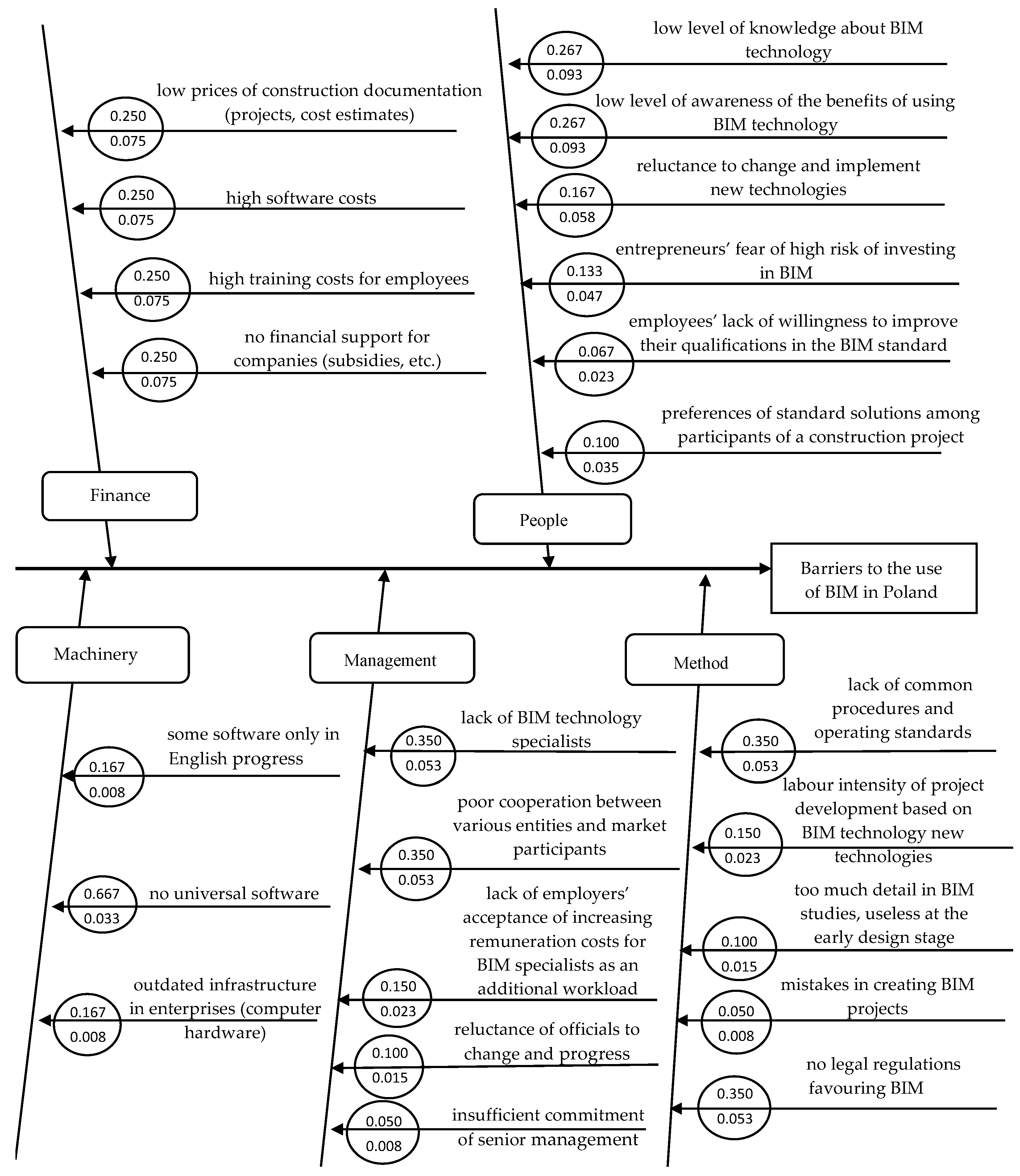

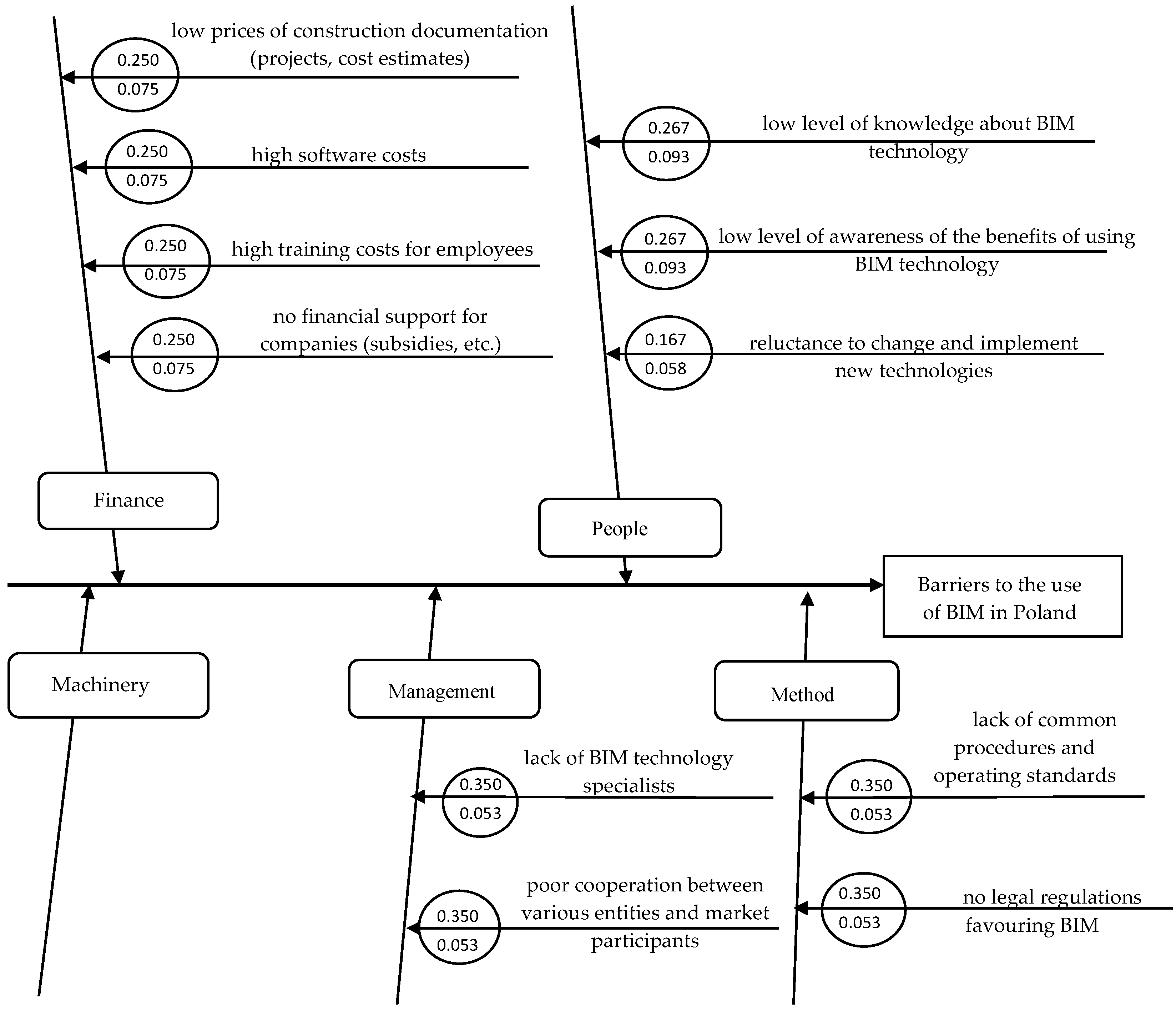
| Country | Year of Publication | Source/Author | The 3 Most Important Barriers Identified |
|---|---|---|---|
| Qatar | 2019 | Mohammed, A., Hasnain, S.A.; Quadir, A [36] |
|
| Malaysia | 2019 | Wong, S.Y.; Gray, J. [37] |
|
| Hong Kong | 2019 | Chan, D.W.; Olawumi, T.O.; Ho, A.M. [38] |
|
| Estonia | 2019 | Ullah, K.; Lill, I.; Witt, E. [39] |
|
| Italy | 2019 | Elagiry, M.; Marino, V.; Lasarte, N.; Elguezabal, P.; Messervey, T. [40] |
|
| Nigeria | 2020 | Olanrewaju, O.I.; Chileshe, N.; Babarinde, S.A.; Sandanayake, M. [41] |
|
| Kazakhstan | 2020 | Aitbayeva, D.; Hossain, M.A. [42] |
|
| Iraq | 2020 | Mahdi, M.M.; Mawlood, D.K. [43] |
|
| Pakistan | 2020 | Farooq, U; Rehman, S.K.U.; Javed, M.F.; Jameel, M.; Aslam. F.; Alyousef, R.; [44] |
|
| China | 2021 | Wu, P.; Jin, R.; Xu, Y.; Lin, F.; Dong, Y.; Pan, Z. [45] |
|
| People | Finance | Method | Management | Machinery | Relative Weight | |
|---|---|---|---|---|---|---|
| People | x | 0.5 | 1 | 1 | 1 | 0.35 |
| Finance | 0.5 | x | 1 | 1 | 0.5 | 0.30 |
| Method | 0 | 0 | x | 0.5 | 1 | 0.15 |
| Management | 0 | 0 | 0.5 | x | 1 | 0.15 |
| Machinery | 0 | 0.5 | 0 | 0 | x | 0.05 |
| Main Category | Symbol | A | B | C | D | E | F |
|---|---|---|---|---|---|---|---|
| People | A | x | 0.5 | 0.5 | 1 | 1 | 1 |
| B | 0.5 | x | 0.5 | 1 | 1 | 1 | |
| C | 0.5 | 0.5 | x | 0.5 | 0.5 | 0.5 | |
| D | 0 | 0 | 0.5 | x | 1 | 0.5 | |
| E | 0 | 0 | 0.5 | 0 | x | 0.5 | |
| F | 0 | 0 | 0.5 | 0.5 | 0.5 | x | |
| Finance | G | H | I | J | |||
| G | x | 0.5 | 0.5 | 0.5 | |||
| H | 0.5 | x | 0.5 | 0.5 | |||
| I | 0.5 | 0.5 | x | 0.5 | |||
| J | 0.5 | 0.5 | 0.5 | x | |||
| Method | K | L | M | N | O | ||
| K | x | 1 | 1 | 1 | 0.5 | ||
| L | 0 | x | 0.5 | 1 | 0 | ||
| M | 0 | 0.5 | x | 0.5 | 0 | ||
| N | 0 | 0 | 0.5 | x | 0 | ||
| O | 0.5 | 1 | 1 | 1 | x | ||
| Management | P | R | S | T | U | ||
| P | x | 0.5 | 1 | 1 | 1 | ||
| R | 0.5 | x | 1 | 1 | 1 | ||
| S | 0 | 0 | x | 0.5 | 1 | ||
| T | 0 | 0 | 0.5 | x | 0.5 | ||
| U | 0 | 0 | 0 | 0.5 | x | ||
| Machinery | W | X | Y | ||||
| W | x | 0 | 0.5 | ||||
| X | 1 | x | 1 | ||||
| Y | 0.5 | 0 | x | ||||
| Main Category | Symbol | Cause | Relative Weight | Absolute Weight |
|---|---|---|---|---|
| People | A | low level of knowledge about BIM technology | 0.267 | 0.093 |
| B | low level of awareness of the benefits of using BIM technology | 0.267 | 0.093 | |
| C | reluctance to change and implement new technologies | 0.167 | 0.058 | |
| D | entrepreneurs’ fear of high risk of investing in BIM | 0.133 | 0.047 | |
| E | employees’ lack of willingness to improve their qualifications in the BIM standard | 0.067 | 0.023 | |
| F | preferences of standard solutions among participants of a construction project | 0.100 | 0.035 | |
| Finance | G | low prices of construction documentation (projects, cost estimates) | 0.250 | 0.075 |
| H | high software costs | 0.250 | 0.075 | |
| I | high training costs for employees | 0.250 | 0.075 | |
| J | no financial support for companies (subsidies, etc.) | 0.250 | 0.075 | |
| Method | K | lack of common procedures and operating standards | 0.350 | 0.053 |
| L | labour intensity of project development based on BIM technology | 0.150 | 0.023 | |
| M | too much detail in BIM studies, useless at the early design stage | 0.100 | 0.015 | |
| N | mistakes in creating BIM projects | 0.050 | 0.008 | |
| O | no legal regulations favoring BIM | 0.350 | 0.053 | |
| Management | P | lack of BIM technology specialists | 0.350 | 0.053 |
| R | poor cooperation between various entities and market participants | 0.350 | 0.053 | |
| S | lack of employers’ acceptance of increasing remuneration costs for BIM specialists as an additional workload | 0.150 | 0.023 | |
| T | insufficient commitment of senior management | 0.100 | 0.015 | |
| U | reluctance of officials to change and progress | 0.050 | 0.008 | |
| Machinery | W | outdated infrastructure in enterprises (computer hardware) | 0.167 | 0.008 |
| X | no universal software platform | 0.667 | 0.033 | |
| Y | some software only in English | 0.167 | 0.008 |
| No. | Cause | Absolute Weight | Cumulative Sum | Reference Area |
|---|---|---|---|---|
| 1 | People—low level of knowledge about BIM technology | 0.093 | 0.093 | 2.053 |
| 2 | People—low level of awareness of the benefits of using BIM technology | 0.093 | 0.187 | 3.920 |
| 3 | Finance—low prices of construction documentation (projects, cost estimates) | 0.075 | 0.262 | 5.233 |
| 4 | Finance—high software costs | 0.075 | 0.337 | 6.397 |
| 5 | Finance—high training costs for employees | 0.075 | 0.412 | 7.410 |
| 6 | Finance—no financial support for companies (subsidies, etc.) | 0.075 | 0.487 | 8.273 |
| 7 | People—reluctance to change and implement new technologies | 0.058 | 0.545 | 8.720 |
| 8 | Method—lack of common procedures and operating standards | 0.053 | 0.598 | 8.963 |
| 9 | Method—no legal regulations favouring BIM | 0.053 | 0.650 | 9.100 |
| 10 | Management—lack of BIM technology specialists | 0.053 | 0.703 | 9.133 |
| 11 | Management—poor cooperation between various entities and market participants | 0.053 | 0.755 | 9.060 |
| 12 | entrepreneurs’ fear of high risk of investing in BIM | 0.047 | 0.802 | 8.818 |
| 13 | preferences of standard solutions among participants of a construction project | 0.035 | 0.837 | 8.367 |
| 14 | no universal software platform | 0.033 | 0.870 | 7.830 |
| 15 | employees’ lack of willingness to improve their qualifications in the BIM standard | 0.023 | 0.893 | 7.147 |
| 16 | labor intensity of project development based on BIM technology | 0.023 | 0.916 | 6.411 |
| 17 | lack of employers’ acceptance of increasing remuneration costs for BIM specialists as an additional workload | 0.023 | 0.938 | 5.630 |
| 18 | too much detail in BIM studies, useless at the early design stage | 0.015 | 0.953 | 4.767 |
| 19 | insufficient commitment of senior management | 0.015 | 0.968 | 3.873 |
| 20 | outdated infrastructure in enterprises (computer hardware) | 0.008 | 0.977 | 2.930 |
| 21 | some software only in English | 0.008 | 0.985 | 1.970 |
| 22 | mistakes in creating BIM projects | 0.008 | 0.993 | 0.993 |
| 23 | reluctance of officials to change and progress | 0.008 | 1.000 | 0.000 |
Publisher’s Note: MDPI stays neutral with regard to jurisdictional claims in published maps and institutional affiliations. |
© 2021 by the authors. Licensee MDPI, Basel, Switzerland. This article is an open access article distributed under the terms and conditions of the Creative Commons Attribution (CC BY) license (https://creativecommons.org/licenses/by/4.0/).
Share and Cite
Leśniak, A.; Górka, M.; Skrzypczak, I. Barriers to BIM Implementation in Architecture, Construction, and Engineering Projects—The Polish Study. Energies 2021, 14, 2090. https://doi.org/10.3390/en14082090
Leśniak A, Górka M, Skrzypczak I. Barriers to BIM Implementation in Architecture, Construction, and Engineering Projects—The Polish Study. Energies. 2021; 14(8):2090. https://doi.org/10.3390/en14082090
Chicago/Turabian StyleLeśniak, Agnieszka, Monika Górka, and Izabela Skrzypczak. 2021. "Barriers to BIM Implementation in Architecture, Construction, and Engineering Projects—The Polish Study" Energies 14, no. 8: 2090. https://doi.org/10.3390/en14082090
APA StyleLeśniak, A., Górka, M., & Skrzypczak, I. (2021). Barriers to BIM Implementation in Architecture, Construction, and Engineering Projects—The Polish Study. Energies, 14(8), 2090. https://doi.org/10.3390/en14082090








